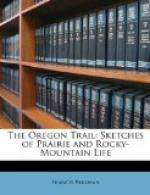The danger of the chase arises not so much from the onset of the wounded animal as from the nature of the ground which the hunter must ride over. The prairie does not always present a smooth, level, and uniform surface; very often it is broken with hills and hollows, intersected by ravines, and in the remoter parts studded by the stiff wild-sage bushes. The most formidable obstructions, however, are the burrows of wild animals, wolves, badgers, and particularly prairie dogs, with whose holes the ground for a very great extent is frequently honeycombed. In the blindness of the chase the hunter rushes over it unconscious of danger; his horse, at full career, thrusts his leg deep into one of the burrows; the bone snaps, the rider is hurled forward to the ground and probably killed. Yet accidents in buffalo running happen less frequently than one would suppose; in the recklessness of the chase, the hunter enjoys all the impunity of a drunken man, and may ride in safety over the gullies and declivities where, should he attempt to pass in his sober senses, he would infallibly break his neck.
The method of “approaching,” being practiced on foot, has many advantages over that of “running”; in the former, one neither breaks down his horse nor endangers his own life; instead of yielding to excitement he must be cool, collected, and watchful; he must understand the buffalo, observe the features of the country and the course of the wind, and be well skilled, moreover, in using the rifle. The buffalo are strange animals; sometimes they are so stupid and infatuated that a man may walk up to them in full sight on the open prairie, and even shoot several of their number before the rest will think it necessary to retreat. Again at another moment they will be so shy and wary, that in order to approach them the utmost skill, experience, and judgment are necessary. Kit Carson, I believe, stands pre-eminent in running buffalo; in approaching, no man living can bear away the palm from Henry Chatillon.
To resume the story: After Tete Rouge had alarmed the camp, no further disturbance occurred during the night. The Arapahoes did not attempt mischief, or if they did the wakefulness of the party deterred them from effecting their purpose. The next day was one of activity and excitement, for about ten o’clock the men in advance shouted the gladdening cry of “Buffalo, buffalo!” and in the hollow of the prairie just below us, a band of bulls were grazing. The temptation was irresistible, and Shaw and I rode down upon them. We were badly mounted on our traveling horses, but by hard lashing we overtook them, and Shaw, running alongside of a bull, shot into him both balls of his double-barreled gun. Looking round as I galloped past, I saw the bull in his mortal fury rushing again and again upon his antagonist, whose horse constantly leaped aside, and avoided the onset. My chase was more protracted, but at length I ran close to the bull and killed him




